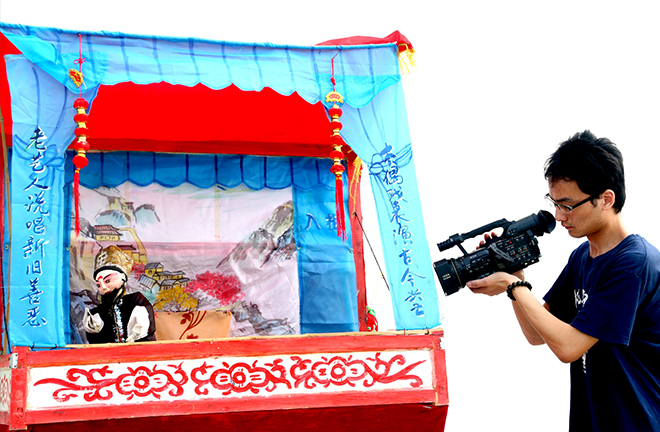Database building for folk stories boosts rural culture

A student films a glove puppet, a folk cultural legacy which is endangered in Yangzhou City, Jiangsu Province. Photo: Cao Yu/CNSphoto
Some people believe that when compared to the sophisticated culture of cities, rural culture is mundane, and folk stories are a linguistic and literary form which “should not be displayed on the stage.” This neglects the value and significance of folk stories.
In fact, in the process of China’s implementation of the rural vitalization strategy, most folk stories conveyed in the form of local dialects have inherited refinement from traditional Chinese language and culture, and embody rural people’s world views, life views and values. Given this, we need to place a high premium on databases of folk stories and allow them to guide our rural vitalization strategy.
This begins with the collection and accumulation of folk stories to best utilize their guiding cultural values. To enhance folk stories’ role in enlightening thoughts and edifying minds, we need to make more efforts in popularizing the stories. Their value in literature, linguistics, history, cultural studies, and the history of thought, should be explored. Database building for folk stories can be upheld as an example for building other folk culture databases in order to realize the systematic value of folk stories.
In addition, digital technology should have deeper applications in this type of database building. Folk story databases are comprehensive, based on network technology, data analysis technology, database technology, visualization technology, geographic information technology, and so on. Database functions would include information classification, collation, inducing, analyzing, and searching. By building databases, folk stories can be effectively preserved and protected, and people are provided with convenient access to platforms for reading folk stories. With technological support for studying folk stories, it also provides scholars of language, literature, geography, history, sociology, and culture with relevant research data. Databases would also amplify advertising for rural regional culture and featured agricultural products. At the same time, it is conducive to marketing rural culture and promoting folk tourism.
According to actual needs of different users, two types of application services can be offered. The first type of service is related to searching and browsing. By browsing animated videos, online picture books, and audio stories through the database, readers can find folk stories they are interested in. With graphic illustrations, audio effects, and other eye-pleasing methods, the database imparts knowledge and engages the imagination and emotion of younger generations. Folk stories also help people gain a deeper understanding of their hometowns—feeling a more personal connection to their local folk culture, they can build a closer emotional bond to their hometowns. The second type of application service is to fix the positions of places where folk stories occurred by means of 3S technologies, which include Geographic Information Systems, Remote Sensing and Global Positioning Systems, VR technology, and AR technology. In this way, people can understand villages’ geographic environments, which will increase the user experience. Users may also have a greater interest in the historical and cultural changes of the local places, and may become more interested in learning about villages.
Finally, database building for folk stories plays a role in inheriting and protecting the refined Chinese cultural legacy. Currently, the Publishing Program of Chinese Folk Literature is collecting, collating, and editing works. The database sets a foundation for the publishing program by setting criterion, classifying, and arranging folk stories according to their subjects. It is also of great significance to demonstrate through database building Chinese rural people’s industrious, courageous, and hard-working qualities, and their wish to live in peaceful, beautiful villages. In recounting the Chinese story to the world, a real China can be displayed in a multi-dimensional and comprehensive way.
Shao Yanmei and Zhang Hongyan are respectively from the School of Chinese Language and Literature and School of Business at Shandong Normal University.
Edited by BAI LE
